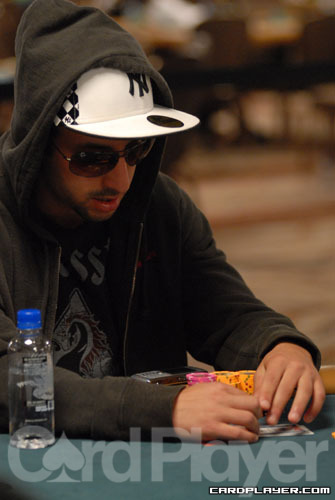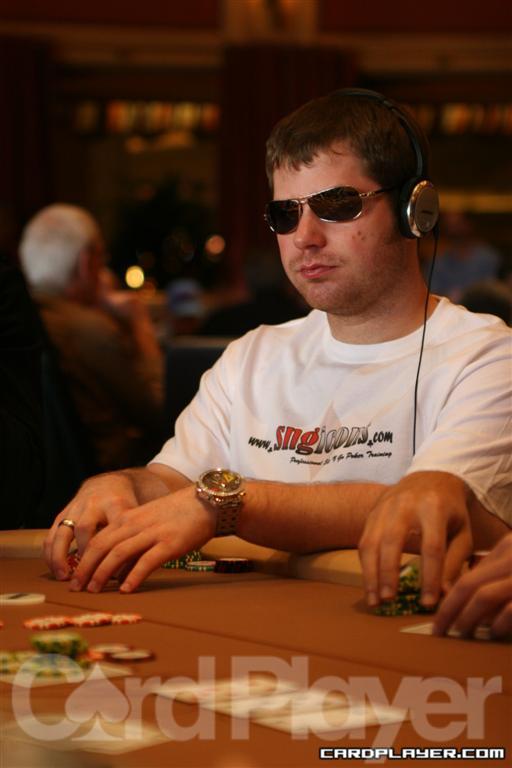






Alec Torelli -- What's My Line?Torelli Talks About Going Back-to-Back at Bellagio |
|
|
 In this special edition of "What's My Line?" we take a look at two key hands that aided Alec Torelli in his unprecedented back-to-back victories at the Bellagio Festa al Lago.
In this special edition of "What's My Line?" we take a look at two key hands that aided Alec Torelli in his unprecedented back-to-back victories at the Bellagio Festa al Lago.
Torelli has had quite the year. He got started with some minor success at the EPT Grand Final and then parlayed that momentum to a fifth place at the LAPT Championship in Costa Rica. One month later, Torelli stormed through an impressive field at the WSOP where he finished second in the heads-up event to Kenny Tran.
The rest of his summer was quiet, but in early October Torelli broke through with not only his first ever live tournament win, but his second just two days later. Incredibly, Torelli defeated former WPT champion Jonathan Little both times heads up to complete the back-to-back accomplishment. For his wins, Torelli banked over $200,000 and a $25,000 seat to the Bellagio’s WPT Championship event in April.
The young up-and-comer, who plays as traheho in some of the biggest online cash games in the world, spoke to Card Player about his recent success and the importance of intense concentration during heads-up play.
Julio Rodriguez: Let’s talk about a huge hand you played three-handed in event no. 4.
| Event - Blinds/Antes | Festa al Lago - Event No. 4 | 6,000-12,000 with a 2,000 ante |
| Player | Alec Torelli | John Gale |
| Chip Counts | About 325,000 | About 220,000 |
| Hand | 2-2 | 6-5 |
The Hand
Down to three-handed, Alec Torelli raised on the button to 30,000 and Jonathan Little folded in the small blind. John Gale made the call from the big blind and the flop came down 8-4-2 rainbow.
Gale checked and Torelli bet 40,000. Gale made the call and the turn paired the board with another 2. This time both players checked and the river was a 3.
Gale bet 30,000 and Torelli raised to 105,000. Gale moved all in for a total of 150,000 and Torelli made the call. Gale showed 6-5 for a rivered straight and Torelli tabled his pocket deuces for quads.
The Interview
 JR: You raised the button with deuces. No mystery there. What’s going through your head when Gale calls from the big blind?
JR: You raised the button with deuces. No mystery there. What’s going through your head when Gale calls from the big blind?
Alec Torelli: He’s calling a wide range there and defending pretty light most of the time. He definitely likes to see a lot of flops, at least at this point in the tournament. The flop gives me bottom set and he checks. I decided to continuation bet, like I had done the entire tournament. When he calls, I know he could be doing this with a large number of hands including A-3, A-5, 6-7, 5-6, 5-3. He could have paired his hand or he could have nothing more than a gut-shot straight draw. I’ve seen him float out of position before, where he just called to take the pot away on a later street, so I had factor in other hands like J-10 high.
JR: The turn is a deuce, giving you quads. Are you checking to allow him to catch up or are you hoping to induce a bluff on the river?
AT: At this point I have the decked completely locked. If he has a hand with low cards that will bet the river I’m going to go ahead and let him. If he’s floating the flop then the turn didn’t help him at all so I’m going to let him hit a pair. Let’s say an ace hits the river, I’m going to let him bluff at it, knowing it’s a card he will try to represent with a hand like J-10.
JR: The river is another low card, a trey, and he leads at the pot for 30,000.
AT: That was a very small bet, so at this point I figured that he might have made a hand. I raised to 105,000 and he moved all in for the rest which I obviously insta-called. He turned over 5-6, which made him double-gutted on the flop. Easy game, I guess.
JR: Let’s move on to the second tournament. Amazingly, you made it down to heads up play and were once again, sitting across the table from none other than Jonathan Little. I want to discuss a hand you played where you made a great call on the river to take the wind out of his sails.
| Event - Blinds/Antes | Festa al Lago - Event No. 5 | 6,000-12,000 with a 2,000 ante |
| Player | Alec Torelli | Jonathan Little |
| Chip Counts | About 450,000 | About 450,000 |
| Hand | 8 5 5 |
A-10 |
The Hand
Jonathan Little raised on the button to 25,000 and Alec Torelli called in the big blind. The flop came J-9-4 with two diamonds and Torelli checked. Little bet 40,000 and Torelli called.
The turn was a 5 and both players checked. The river was a non-diamond King and Torelli checked. Little bet 65,000 and after some thought, Torelli made the call. Little showed A-10 high and Torelli tabled his pair of fives to take the pot.
The Interview

AT: I was playing pretty aggressive post flop and had been check-raising a good amount of hands, so I called knowing that my check-raise might not work. He could put in another raise, forcing me to play for all my chips as a 2-1 underdog. If I make it 120,000 on the flop, he might move in and I’d be in a pretty awkward spot holding just a flush draw. I’d be getting about 1.5-1 to call and if I factored in the occasional push with a worse flush draw or open-ended straight draw, I might have been forced to call in a spot where I was way behind.
Also, by check-calling, my hand looks more like a made hand, making it easier to take the pot away on the river if I don’t get there.
JR: The turn was a five, pairing your hand, and you checked once again.
AT: I was planning on check-calling the turn and reevaluating on the river, knowing he was capable of betting with hands like K-Q, K-10, Q-10, 10-8, 9-7, basically all the straight draws. He might even be betting hands like A-3 or A-2 that improved to wheel draws or better flush draws than mine, which I now beat since I paired.
The only hands that beat me that he would bet on the turn are top pair hands like J-10 plus. He wouldn’t bet any hands that had a nine in them because he’d most likely go for pot control. Factoring all that into the equation, I can beat most of the hands that he would bet the turn with.
JR: Well, after all that thought, he ended up checking behind.
AT: Exactly, so now we know a bit more about his hand. He might have a hand like pocket sixes or better, or he has a nine for pot control, but he never has a Jack. He would definitely bet a jack on the turn because of all the draws on board, knowing that I’m either in check-call or check-fold mode.
JR: The river is a king and you missed your flush. You now have fourth pair and check it again. He bets 65,000 and you correctly make the call. What was your thought process there?
AT: Okay, so now I have to break down all the hands that fit his line. He can’t have made a straight with Q-10, since we already established that he would have bet the turn. The same goes for K-Q or K-10. K-J isn’t a possibility because we know he can’t have a jack in his hand.
I’m think to myself about the hands he could possibly be value betting. We can now eliminate most of the nines from his range, since he would probably check knowing I might be holding a king. So the only hands that he could be betting that beat me are K-2, K-3, K-4, K-5, K-6, K-7, K-8 or K-9. Two pair is unlikely so that almost eliminates half of these holdings.
Now we think about all of his other hands that got to the river, which is essentially most of his range. Because he raises the button and bets mosts flops, there is a strong possibility that he is holding a hand like ace-high, Q-7 offsuit and the like. He also knows that the King was a bad card for me if I have a pair like sixes, sevens or eights, so he’s likely to bluff at it with those types of hands.
I made the call and my pair of fives were good. That gave me the chip lead and momentum. I continued to grind him down and finally my A-10 held up against his Ks9s for the second win.
Heads-Up Play – The Process of Elimination
JR: You were able to quickly rattle off every likely holding for your opponent, narrowing their ranges down to a manageable number. In full ring games, players are capable of holding just a few possible combinations that connect with the board or complete air. But it seems that in heads up play, because the range becomes so much larger, you almost have to use the process of elimination to read your opponent.
AT: Definitely, I’m always using that method whether I’m playing in a tournament or sitting down for a cash game session. That’s why I can’t play my A-game for 12 hours at a time. Sure, if I zone out and don’t pay attention to the game, I could probably coast through a 12-hour day. It’s like playing chess, but only knowing the rules. Sure you can keep moving the pawn up a space and even get lucky a few times to win a few pieces, but if you aren’t thinking a few moves ahead you’re eventually going to get outplayed.
It’s draining to sit there and go through everyone’s range for every hand, every pot for the entire day. That includes hands I’m not involved in, as well. Poker is not a leisure activity if you play it correctly. It can be very mentally taxing.
This is especially true for heads up play, where you must be able to narrow someone down to a finite point. If you happen to be off by 5 percent, that could be the difference between a call or a fold, a win or a loss. The worst feeling in the world is finishing second and when I get to that point, I’m going to make sure that I did everything I could to keep that from happening.
